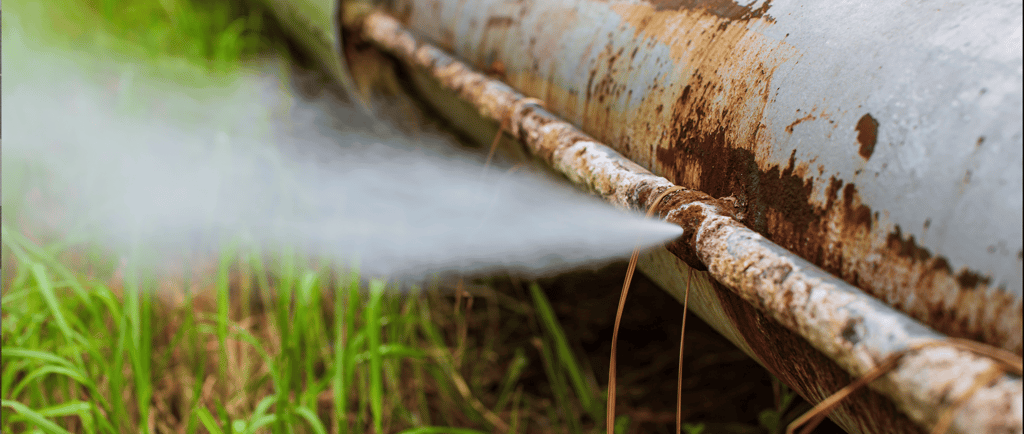How to Spot Early Signs of Pipe Corrosion
Learn to identify warning signs of corroded plumbing—from discoloration to pinhole leaks. Protect your home’s water quality and prevent costly damage with these expert tips.
PLUMBING
3/27/202510 min read


What This Post Covers
The basics of pipe corrosion and how it develops over time
Common red flags—from discolored water to reduced flow—that signal early corrosion
Methods for inspecting both visible and hidden plumbing
DIY checks vs. professional diagnostic tools
Preventive strategies (e.g., water treatment, pipe material choices)
Safety considerations and when to call for expert help
Support from SuperTech Industries to safeguard your plumbing
Why Pipe Corrosion Matters
Pipe corrosion is more than just a nuisance—it can undermine your entire home’s water supply and even compromise structural elements if severe leaks develop. Corrosion typically involves a chemical or electrochemical reaction between water, metal, and sometimes environmental factors like oxygen or minerals. Over time, the inside surface of pipes breaks down, thinning walls, spawning leaks, and shedding rust or contaminants into your household water.
Unnoticed corrosion can escalate from harmless discoloration in faucets to catastrophic pipe bursts. The earlier you detect it, the more control you have over mitigating damage and expenses. Suppose you observe subtle cues—like tiny pinhole leaks, a slight metallic taste in water, or a mysterious damp spot near a pipe run. In that case, you might be witnessing the first stage of pipe corrosion. Addressing the issue in these early stages often means simpler (and cheaper) fixes, like swapping out a single pipe segment or installing a water filtration system to adjust pH levels.
This post delves into how to recognize the signs of corroded plumbing, the main causes behind it, and practical steps to keep your pipes in prime condition. Whether you’re a homeowner seeking knowledge or a DIYer aiming to protect your property, understanding corrosion fundamentals can save you from both water damage and unnecessary stress. And if the damage extends beyond a minor fix, SuperTech Industries offers the professional guidance you need, from comprehensive inspections to full repiping solutions.
Corrosion 101: How It Happens
To spot corrosion early, you’ll benefit from a brief overview of how metals break down. In many homes, pipes are made of copper, galvanized steel, or older cast iron (for sewer lines). Each metal interacts with water differently, but similar corrosion processes can occur:
Oxidation
Oxygen in water or air reacts with the metal pipe surface, forming oxides or rust. For instance, iron-based pipes develop red rust, while copper may form greenish or bluish deposits (patina).
Electrochemical Reactions
In some systems, especially if there’s an imbalance in pH or dissolved ions, water can set up galvanic cells within the pipe. One part of the metal acts as the anode (where corrosion accelerates), and another acts as the cathode.
Mixed-metal plumbing (like copper and steel in contact) can intensify galvanic corrosion.
Chemical Content in Water
High chloride concentrations, low or high pH, and certain minerals can accelerate corrosion. Hard water deposits can form scales that eventually trap moisture, ironically leading to more localized corrosion beneath the buildup.
Velocity and Erosion
Rapid water flow, especially with abrasive particles, can physically erode the inner pipe surface. Over time, this mechanical effect pairs with chemical corrosion, compounding damage.
Corrosion can be uniform—spread over large pipe sections—or localized, forming pits or pinholes. A single pinhole leak might appear negligible but can escalate into more significant issues if neglected. Understanding these basic processes highlights why early detection is vital.
Early Warning Signs of Corrosion
1. Discolored or Cloudy Water
Rusty, Brown, or Reddish Tints
When you turn on the tap, if the water briefly runs rusty or there’s a constant orange hue, your pipes may be dissolving iron or steel. Sometimes the internal rust flakes off, mixing with water.Blue/Green Stains
Copper pipes that corrode can leave bluish-green stains around sinks or drains. This patina might also show up on pipe exteriors or in a tub that occasionally runs tinted water.Cloudiness or Particles
Tiny rust flakes or other sediments sometimes appear suspended in water, giving it a foggy look. Though certain municipalities flush mains that cause short-lived cloudiness, persistent issues often trace back to corroded lines.
DIY Checks
Fill a clear glass with cold water first thing in the morning (when pipes have sat unused). Let it settle. If rust particles or color appear, it suggests interior pipe corrosion. If the color is ephemeral, it may be from the local main lines. Re-check with water from a different tap to see if the phenomenon is localized.
2. Metallic or “Off” Taste and Odor
Taste: If cold tap water tastes metallic or bitter, corrosion might be releasing dissolved metals into the supply. This is more common in older galvanized or copper lines.
Smell: A faint metallic aroma can accompany such water. Also, note sulfur or “rotten egg” scents could point to other issues like bacteria or well problems, but occasionally metal corrosion combined with certain water chemistries can produce odd smells.
DIY Checks
Taste test from multiple taps (kitchen vs. bathroom). If the metallic tang only appears in the bathroom sink, it’s likely that branch line or faucet. If you notice it in all taps, the main supply line or entire house piping could be suspect.
3. Unexplained Low Water Pressure or Flow
Gradual Reduction: Corrosion often builds up scale and rust that narrows the pipe’s interior diameter. Over months or years, water flow can drop.
Localized vs. Whole House: If a single fixture has dwindling flow, that pipe run may have corroded more severely. Pervasive low flow across the house might hint at extensive corrosion in the main line or multiple segments.
DIY Checks
Detach faucet aerators or shower heads. If the screen is clogged with rust flakes, that’s a strong sign corroded pipe material is traveling through. Clean them out and see if flow improves temporarily.
Check static pressure from an external hose bib. If it’s strong there but weak indoors, you might have internal line restrictions.
4. Pinholes, Drips, or Damp Spots
Pinhole Leaks: Copper pipes are known for developing small, localized pinholes where pitting corrosion attacks from within. Initially, it might only be a slow drip.
Damp Drywall or Ceiling Stains: In a multi-story home, a hidden corroded line upstairs can cause moisture in walls or ceilings. You might see paint bubbling or mild discoloration.
Musty Smells: If a corroded pipe leaks behind walls, mold or mildew can start, creating a persistent musty odor.
DIY Checks
Periodically inspect exposed pipes in basements, crawl spaces, or utility rooms for wet spots or greenish crust around joints.
Keep an eye on the water meter. If it ticks upward while no faucets are running, you might have an unseen leak. This can be a prime clue that corrosion has led to a small crack or hole.
5. Frequent Clogging or Rust Particles in Appliances
Clogged Washing Machine Fill Screens: Many appliances have internal filters or screens that can trap rust flakes or corroded debris. If these screens constantly clog, suspect upstream corrosion.
Recurrent Faucet Strainer Build-Up: Kitchen faucets often feature fine mesh aerators. If you keep finding gritty, rusty deposits, your pipes could be flaking from within.
Discolored Ice Cubes: Refrigerators with icemakers can produce off-color ice if the supply line is corroded.
DIY Checks
Inspect these small appliance screens every few months. If you find repeated rust or metal bits, consider investigating your pipe’s interior condition or water quality.
Assess the piping material leading to each appliance. Sometimes a rubber or plastic supply line may slow or mask signs of rust from a corroded upstream line—but the debris still arrives.
Methods for Inspecting Pipes and Confirming Corrosion
Visual Examinations
Though many pipes hide behind walls, some might run through basements, garages, or crawl spaces. Look for:
External Rust: Iron or steel pipes might have brownish-red corrosion on surfaces or around threads.
Verdigris on Copper: Green or bluish crust near joints indicates oxidation and potential leaks.
Flaking, Pitting, or Bulges: Any unusual texture changes or lumps can be a precursor to actual holes.
Tip: Use a flashlight or camera phone to capture hidden nooks. If you see a suspicious patch, mark its location for closer attention or to show a professional later.
Water Testing for Metal Content
Sometimes you’ll want to confirm if elevated iron, copper, or other metals are shedding from pipes. Third-party labs or DIY test kits measure:
Iron (Fe)
Copper (Cu)
Lead (in older lead-solder or lead pipes)
pH and Hardness (not a metal, but relevant to corrosion potential)
A consistent presence of high metal levels might confirm internal corrosion if the municipality or well water source typically tests lower. This helps differentiate between your home’s plumbing issues vs. supply line variations.
Advanced Tools (Professional Inspections)
Borescopes or Camera Inspections: Plumbers can thread a small camera into accessible pipes (like drain lines or large diameter mains) to visually confirm pitting or rust build-up.
Ultrasonic Thickness Testing: Non-invasive measurements that gauge the pipe wall’s thickness. Particularly used in industrial or commercial settings but can help detect advanced thinning in older steel lines.
Corrosion Coupons: Some setups place small metal samples in the water flow to see how quickly they corrode. More typical in commercial cooling towers or large systems, though.
Thermal Imaging: While more about leak detection, heat variations on a pipe run might highlight ongoing moisture or corrosion issues behind walls.
Note: If your home is 40+ years old with galvanized steel lines, a thorough professional inspection might prove wise. These lines commonly degrade from the inside out.
Preventive Measures and Mitigation
Address Water Quality
Sometimes adjusting your home’s water chemistry stops or slows corrosion significantly. Options include:
Water Softening: Hard water fosters scale, ironically providing partial metal protection. But in some systems, softened water can become more corrosive if not balanced properly.
pH Neutralization: If your water is acidic (low pH), it’s more likely to leach metals from copper or iron pipes. A neutralizer system uses calcite media or soda ash injection.
Chlorides and TDS: Elevated chloride levels accelerate corrosion, especially in stainless or copper lines. Reverse osmosis or partial desalination might help if feasible.
Tip: Acquire a professional water test to see if a pH correction or corrosion inhibitor is recommended. Even a small shift in chemistry can produce big results in pipe longevity.
Pipe Replacement or Relining
If corrosion is extensive, partial or full repiping might be the only lasting remedy. Popular upgrades include:
Copper to PEX: Many homeowners prefer PEX (cross-linked polyethylene) for its ease of install, flexibility, and immunity to rust.
Galvanized to CPVC: If you currently rely on galvanized lines, switching to CPVC can eliminate future rust while retaining high temp tolerance.
Epoxy Coatings: In some markets, professionals offer in-place pipe lining. They clean the pipe’s interior, then coat it with epoxy. This can be an option if tearing out walls for a complete repipe is impractical.
Warning: Partial replacements can cause “mixed-metal” corrosion if, say, you connect copper to existing galvanized steel without dielectric unions. This galvanic mismatch might accelerate trouble in the transition joint. Consult a plumber or bridging device for safe transitions.
Routine Maintenance and Observation
Flush Sediments: On seldom-used lines or water heaters, flushing out rust or deposits helps. Water heaters especially need annual or semi-annual flushing to reduce scale.
Filter and Cartridge Changes: If you employ a sediment filter or whole-home system, timely filter swaps keep water flow and protect pipes.
Inspect Exposed Pipes Yearly: Check for dampness, new rust spots, or suspicious color changes.
Monitor Pressure: High water pressure can exacerbate pinhole leaks. A pressure regulator set around 50–65 psi can reduce mechanical stress on aging pipes.
Check Water Heater Anode Rod: If the anode rod in your heater is consumed, the heater tank walls might corrode faster and lead to rust-laden water.
When to Call in the Pros
While many tasks, like visually checking pipes or sampling water, lie within DIY territory, advanced corrosion scenarios call for professional expertise. Signs you should contact an expert include:
Multiple Leaks: If you patch one pinhole but more keep sprouting, the entire line is likely compromised. A plumber can advise if repiping is more cost-effective than chasing repeated leaks.
Major Rust Chunks or Stains: If your water runs stained daily, it might be an issue in the main line or widespread internal corrosion.
Pipe Bulges or Large Cracks: Thin pipe walls risk catastrophic bursts that can flood your home. Replacing them proactively is crucial.
Need for Complex Water Treatments: If your pH or chemical levels require special systems or if you suspect lead lines, professional testing and solutions are imperative.
Here is where SuperTech Industries steps in with thorough inspections, advanced detection techniques, and well-honed solutions. Instead of patchwork fixes, we aim for Simple Solutions. Superior Results.—a philosophy meaning your plumbing returns to robust condition with minimal hassle or repeated interruptions.
Scenario Example: Aging Galvanized Steel in a 1970s Home
A homeowner notices slight rust color when first running hot water in the morning and a significant dip in flow from the kitchen tap. They remove the faucet aerator and find small flakes of rust. That weekend, they spot a new brownish stain on the basement ceiling under a main supply line, and the pipe’s exterior reveals scaly rust. Fearing a major leak soon, they call a professional.
A plumber from SuperTech Industries examines the entire system, discovering multiple areas of rust infiltration. The home’s galvanized lines, now ~50 years old, are near the end of their lifespan. Replacing them with PEX or copper emerges as the recommended long-term fix. Alternatively, sections might be replaced piece by piece, but with corrosion widespread, a full repipe is more reliable. They also advise the homeowner to install a pressure-reducing valve since the municipal pressure is 80–90 psi—a factor exacerbating pinhole leaks. After the repipe, the water flows at consistent pressure, runs clear, and the risk of sudden ruptures plummets.
Action Steps and Safeguarding Your Home
1. Conduct a Visual Survey: At least once a year, examine exposed pipes in basements or behind access panels. Look for color changes, wet spots, or crusty buildup near joints.
2. Test Water Periodically: If you suspect rising metal content, send a sample to a lab or use reliable test kits.
3. Monitor Your Water Heater: Regular flushes and anode rod checks can stave off rust-laden output.
4. Track Pressure and Flow: Notice any creeping drop in flow or mysterious pressure spikes.
5. Seek Professional Guidance for Uncertainties: Don’t wait for a major leak to confirm advanced corrosion.
Partnering with SuperTech Industries for Peace of Mind
If your home’s plumbing shows signs of corrosion, from recurring rusty water to minor leaks or worrying pipe textures, our team can pinpoint the root cause:
Video Camera Inspections: We navigate cameras through drains or partial supply lines to visually confirm where rust is most severe.
Non-Destructive Testing: For older steel lines, we can measure pipe thickness and recommend partial or entire replacements.
Water Treatment Solutions: If pH or mineral content accelerates corrosion, we help implement softeners, neutralizers, or filtration as needed.
Repiping Expertise: Our technicians replace failing lines with modern materials and best practices, ensuring minimal disruption to your day-to-day activities.
“Don’t just call a tech, call a supertech.” Our decades of plumbing experience mean any scope—small or large—receives meticulous handling. From diagnosing subtle warning signals to implementing a new piping system, we provide Simple Solutions. Superior Results.
Wrapping Up
Spotting early signs of pipe corrosion can spare you from the chaos of sudden pipe bursts, extensive water damage, and health concerns tied to rust-laden water. Keeping an eye on discoloration, taste changes, reduced flow, or pinhole leaks grants the time to act before small annoyances become massive undertakings. And while every homeowner can observe basic indicators, major corrosion or uncertain conditions may require skilled inspections or water chemistry adjustments.
In short, proactive vigilance—pairing routine checks with minor maintenance—maintains a resilient plumbing network. Should deeper problems surface, consider calling professionals like SuperTech Industries to guide you in either rehabilitating older lines or upgrading them for a more reliable future. Corrosion is a slow-moving adversary, but with attention to detail and prompt intervention, you can keep your home’s water supply clean, consistent, and worry-free.
SuperTech Industries
Your trusted partner for all your solutions.
KNOWLEDGEABLE - AFFORDABLE - ADAPTABLE - DEPENDABLE
© 2024. All rights reserved.
1530 E Williams Field Road
Ste. 201
Gilbert, AZ 85295


